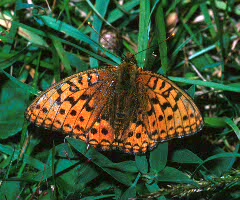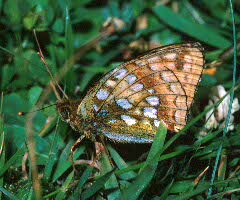High Brown Fritillary
Argynnis adippe

| Home | The Butterflies of Gloucestershire | Species | Habitats | Conservation |
High Brown FritillaryArgynnis adippe |
 |
 |
| 9 July 1988 | 9 July 1988 |
Habitat
The High Brown Fritillary needs open woodland or scrubby grassland
habitat, using Common Dog-violet Viola riviniana as its larval
foodplant. The larvae need very warm conditions at ground level, and
suitable British sites have become progressively scarcer during the
20th century.
Conservation Issues
Loss of habitat through changes in management and land use have already
caused a serious reduction in its national distribution. Active
conservation management is necessary to halt the decline and restore
suitable habitat where possible, in order to prevent local extinctions.
Isolated colonies are particularly vulnerable.
Numbers reported at the remaining colony in our area have been very low, and its survival into 2000 is uncertain.
|
Flight PeriodHigh Brown Fritillary adults are seen in July.
DistributionThere has only been one known colony in the area for many years, and although there have been a few records from other places, some of these are almost certainly optimistic misidentifications of Dark Green Fritillary, which is on the wing at the same time and sometimes found in similar habitat to the High Brown.Attempted introductions have probably been made by enthusiasts. This seems the most likely explanation when several specimens of such a scarce species are found in one season far from any known colony, and not seen in the same place again.
| No map - species found in just one place |